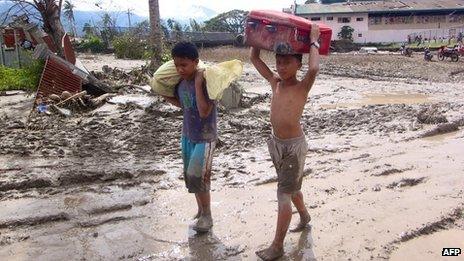Access to technology 'aids survival in natural disaster'
- Published

Widespread access to mobile phones in the Philippines is credited with saving many lives during Typhoon Bopha
Some of the countries most prone to natural disasters also have least access to life-saving communications and technology, a major study says.
Such access has a major impact on people's ability to prepare for, survive and recover from disasters.
In the Philippines, for example, 99% of people can access a mobile phone.
Text messaging and Twitter saved many lives in a 2012 typhoon, the International Federation of the Red Cross and Red Crescent says.
Other examples of technology helping save lives or aid recovery include the use of text messages to deliver hurricane warnings in Haiti and a computerised barcode system to monitor the distribution of humanitarian supplies in Syria.
Increase resilience
The author of the IFRC's annual World Disasters report, external notes that while "the overall number of people affected by disasters decreased in 2012, the number of people affected in the poorest countries increased, with over 31.7 million people affected".
"They are also often the ones with the least access to technology," said Patrick Vinck.
IFRC Secretary General Bekele Geleta expressed hope that "governments and affected people in disaster-prone countries can take advantage of innovations such as weather prediction software, satellite imagery and mass alert systems, increasing their resilience to disasters and their ability to recover quickly when they do happen".
"Typhoon Bopha affected 6.3 million people in the Philippines, and thousands of lives were saved because 99% of the population have access to a mobile phone and could receive early warnings and information on staying safe." he said.
However the report also warns that humanitarian agencies should not make the mistake of listening only to those who are connected and excluding those who are not.
It urges the private sector, humanitarian organisations, governments and local communities to work together to ensure access to technology for such populations.
- Published16 October 2013
- Published10 December 2012
- Published29 November 2010